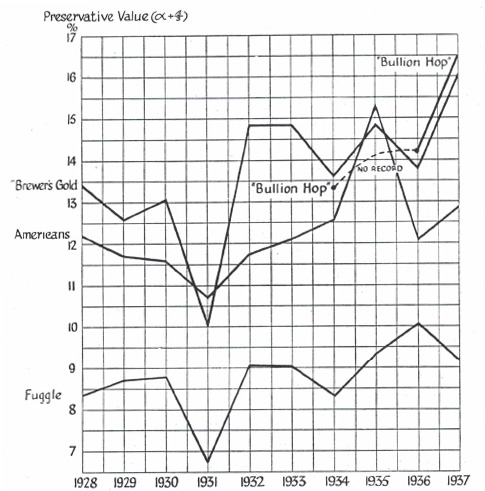I originally intended to include a few paragraphs about this in the next volume of Hop Queries but it grew a bit longer. The free newsletter will mail Friday.
“Too bitter, rank and slightly unpleasant” in 1935. The winner in judging for the British Hop Awards for 2017.
Can you name that hop?
A hint. Her sister is 19 percent of the pedigree of Citra.
Her name is Bullion, she isn’t widely grown, and when she was more popular in the 1940s it was because of her bittering qualities. But the 74th Institute of Brewing & Distilling’s annual competition judges chose her from 196 entries (29 varieties) for her “complex and outstanding aroma, which encompassed both floral and tropical notes over a deep base of earthy spice.”
The result, which could be described as an upset of far greater magnitude than the Philadelphia Eagles defeating the Boston Patriots in the Super Bowl, says something about how what’s considered desirable in hops has changed in recent years as well as Ross and Peter Hukins hop growing and processing skills.
The competition was judged shortly after harvest last fall and IBD chief executive Jerry Avis said for a press release. “This year it is particularly encouraging to see one of the new generation of hop growers emerge as overall champion, demonstrating that the continuing tradition of great British hop growing has a vibrant and exciting future.”
The Hukins family has been growing hops in Kent for more than 100 years and their Fuggle was a winner in the 2016 IBD competition. “In such a great growing year for British Hops, showcasing great quality, we were delighted our sample was judged the overall winner. A lovely touch for my father, Peter, whose idea it was to re-introduce Bullion to the farm,” said Ross Hukins. Peter’s father won the IBD competition with it in 1960, it was one of his favorites, and “57 crops later it was great to see it recognized again.”
Do not look for Bullion to be the next Citra, Mosaic or Galaxy. But its place in history (or at least as the answer to a trivia question) was assured long ago. The short version (the first chapter of For The Love of Hops begins with the longer version):
E.S. Salmon changed the future of hops when he began cross breeding varieties of American heritage and those from England. A cross in 1918 between a hop collected from the wild in Manitoba and an unknown English male resulted in offspring that included varieties that would be called Brewer’s Gold and Bullion. Salmon’s goal was to give growers the opportunity to grow hops that exceeded “in preservative value the richest imported American varieties.” As this chart from “Notes on Hops” in 1938 illustrates Brewer’s Gold and Bullion succeeded in doing that.

Farmers in the United States and Canada were quick to plant the varieties, but neither received wide acceptance in England. It’s not clear if brewers rejected them because they thought them truly objectable or simply because they were different and bolder. One said that a general characteristic of the “American hop is that it is rather a stronger bitter than the European hop, and with a stronger scented flavor in many cases.” What changed? Drinkers want aromas and flavors they didn’t in the past (perhaps because brewers did not offer them, but that is another discussion). Varieties that include genetic material found in hops that once grew wild in North America have more of the compounds that contribute to those aromas and flavor. End of short version.
The IBD judges assessed the hops on a number of criteria, such as quality and intensity of aroma and trueness to variety type. The winners were:
– Le May Cup for best sample of Goldings – Winner: Coombe Jones
– Hop Merchants Cup for best sample of hops (from each category) bought on the basis of their aroma: Hukins Hops (Bullion); Hukins Hops (Challenger); C W L Wilson (Pilgrim)
– Brewers Cup for best sample of High Alpha content hops – Winner: C R & G Daws (Admiral)
– Wigan Cup: for best sample of Fuggle – Winner: J W Spilsbury & Co
– Botanix Cup for best sample of Dwarf/Hedgerow variety – Winner: C & R Edmed (First Gold)
– Grower’s Challenge Bowl awarded for the best sample of new English variety – Winner: M & L Andrews (6106 – an un-named variety as yet)
Bullion was once a numbered hop called Q43. It won’t be a surprise if 6106 gets gets a name, but it would be bold to suggest it will be winning awards 70 years after its release.